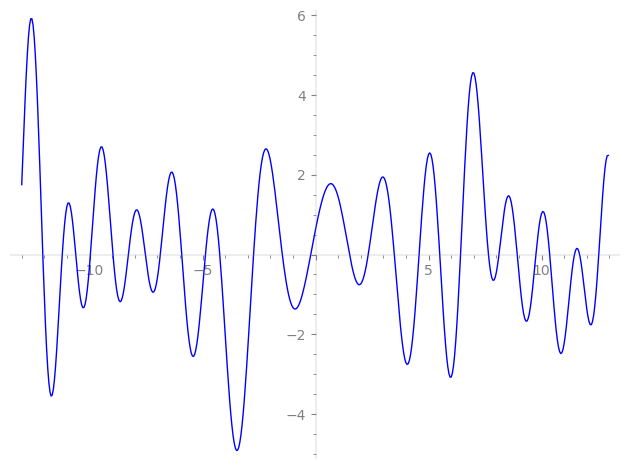| L(s) = 1 | + (−1 + i)2-s − 2i·4-s + (5.44 − 5.44i)7-s + (2 + 2i)8-s − 3·11-s + (−2.32 − 2.32i)13-s + 10.8i·14-s − 4·16-s + (−4.34 + 4.34i)17-s − 22.6i·19-s + (3 − 3i)22-s + (−17.0 − 17.0i)23-s + 4.65·26-s + (−10.8 − 10.8i)28-s + 9.30i·29-s + ⋯ |
| L(s) = 1 | + (−0.5 + 0.5i)2-s − 0.5i·4-s + (0.778 − 0.778i)7-s + (0.250 + 0.250i)8-s − 0.272·11-s + (−0.178 − 0.178i)13-s + 0.778i·14-s − 0.250·16-s + (−0.255 + 0.255i)17-s − 1.19i·19-s + (0.136 − 0.136i)22-s + (−0.740 − 0.740i)23-s + 0.178·26-s + (−0.389 − 0.389i)28-s + 0.320i·29-s + ⋯ |
\[\begin{aligned}\Lambda(s)=\mathstrut & 1350 ^{s/2} \, \Gamma_{\C}(s) \, L(s)\cr =\mathstrut & (-0.608 + 0.793i)\, \overline{\Lambda}(3-s) \end{aligned}\]
\[\begin{aligned}\Lambda(s)=\mathstrut & 1350 ^{s/2} \, \Gamma_{\C}(s+1) \, L(s)\cr =\mathstrut & (-0.608 + 0.793i)\, \overline{\Lambda}(1-s) \end{aligned}\]
Particular Values
| \(L(\frac{3}{2})\) |
\(\approx\) |
\(0.6348707321\) |
| \(L(\frac12)\) |
\(\approx\) |
\(0.6348707321\) |
| \(L(2)\) |
|
not available |
| \(L(1)\) |
|
not available |
\(L(s) = \displaystyle \prod_{p} F_p(p^{-s})^{-1} \)
| $p$ | $F_p(T)$ |
|---|
| bad | 2 | \( 1 + (1 - i)T \) |
| 3 | \( 1 \) |
| 5 | \( 1 \) |
| good | 7 | \( 1 + (-5.44 + 5.44i)T - 49iT^{2} \) |
| 11 | \( 1 + 3T + 121T^{2} \) |
| 13 | \( 1 + (2.32 + 2.32i)T + 169iT^{2} \) |
| 17 | \( 1 + (4.34 - 4.34i)T - 289iT^{2} \) |
| 19 | \( 1 + 22.6iT - 361T^{2} \) |
| 23 | \( 1 + (17.0 + 17.0i)T + 529iT^{2} \) |
| 29 | \( 1 - 9.30iT - 841T^{2} \) |
| 31 | \( 1 - 8.04T + 961T^{2} \) |
| 37 | \( 1 + (4.77 - 4.77i)T - 1.36e3iT^{2} \) |
| 41 | \( 1 - 52.0T + 1.68e3T^{2} \) |
| 43 | \( 1 + (45.7 + 45.7i)T + 1.84e3iT^{2} \) |
| 47 | \( 1 + (51.0 - 51.0i)T - 2.20e3iT^{2} \) |
| 53 | \( 1 + (26.6 + 26.6i)T + 2.80e3iT^{2} \) |
| 59 | \( 1 - 68.3iT - 3.48e3T^{2} \) |
| 61 | \( 1 - 61.6T + 3.72e3T^{2} \) |
| 67 | \( 1 + (87.7 - 87.7i)T - 4.48e3iT^{2} \) |
| 71 | \( 1 + 88.4T + 5.04e3T^{2} \) |
| 73 | \( 1 + (62.4 + 62.4i)T + 5.32e3iT^{2} \) |
| 79 | \( 1 + 78.8iT - 6.24e3T^{2} \) |
| 83 | \( 1 + (-18.6 - 18.6i)T + 6.88e3iT^{2} \) |
| 89 | \( 1 - 50.5iT - 7.92e3T^{2} \) |
| 97 | \( 1 + (46.0 - 46.0i)T - 9.40e3iT^{2} \) |
| show more | |
| show less | |
\(L(s) = \displaystyle\prod_p \ \prod_{j=1}^{2} (1 - \alpha_{j,p}\, p^{-s})^{-1}\)
Imaginary part of the first few zeros on the critical line
−8.962738927084434906646419475215, −8.281823463739631023650117390472, −7.53086394458448780695454280576, −6.86975324770195891646149407158, −5.92073088845652032769297673348, −4.87188397908826669470577385503, −4.23901322192465169780087229569, −2.74341890662993674102046281576, −1.47135235014055696421039470546, −0.21325082772583066551736121508,
1.50383179527476599512305968263, 2.32909958729042507874298490569, 3.48416911977597981515360989811, 4.57918490596121375719445643866, 5.49446016635323147898372835644, 6.41434999632264782329819406405, 7.65012645639995648398508016250, 8.113440332404260116162053363012, 8.921864055383665522183466513823, 9.749576606811578539452870075640

